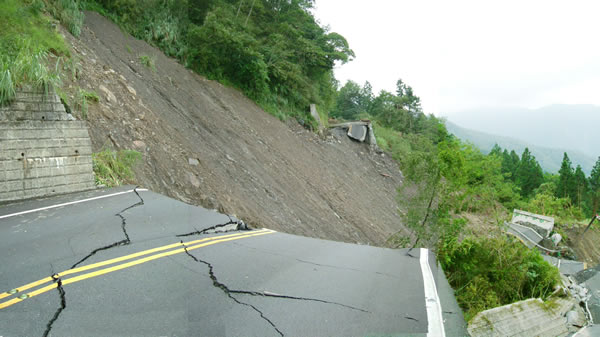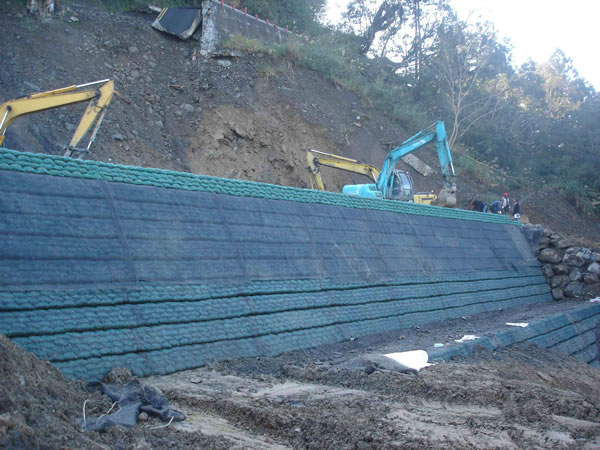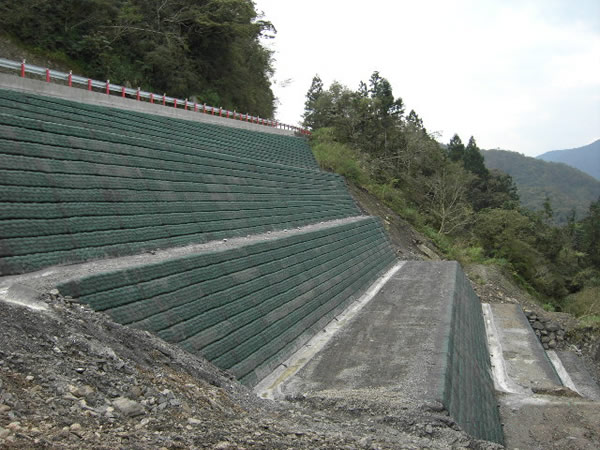|
Stretches of the Yi-Lan-I Road in Taiwan are located more than 3200 ft. (1000 m) above sea level. It’s an important road and provides the primary access to the National Taipingshan Forest Recreation Area. But during a particularly rainy 2.5-month period (mid-July to October 2005), the region experienced an abundant amount of rain in the wake of 7 powerful typhoons. According to Taiwan’s central weather bureau, 39 in. of rain (1 m) fell during this period. The results were dangerous, especially for such an elevated road. Portions of the slope became unstable. Sliding occurred. The road was damaged and use was restricted for more than six months. |
 |
Calling for Reinforcements
The slope needed to be reinforced. In this case, a wrap-around facing was selected.
The designers chose to construct a 230-ft. (70-m) long slope along the original road line. The reinforced slope height would then range from 72 ft. (22 m) to 100 ft. (30.5 m) and would follow the in-site landforms—a rather steep slope of 1:0.5 (V:H)!
The reinforcement was to be carried out over 6 stages along the varying road slope. Each stage measured more than 15 ft. (5 m).
The embedment lengths for these stages were designed at 59 ft. (18 m), 59 ft., 52 ft. (16 m), 39 ft. (12 m), 29 ft. (9 m) and 20 ft. (6 m). The project team specified ACE geogrids made of multifilament polyester yarns and coated with PVC. Three products were chosen to handle the various needs of the stages. The ultimate design strengths for the geogrids were 200 kN/m, 150 kN/m and 100 kN/m.
Two piles were driven under the base of the reinforced slope’s first stage. The piles were 29 ft. (9 m) long and 1 ft. (0.3 m) in diameter, and were driven 3 to 6 ft. (1 to 2 m) into the bedrock. Soon after, a thorough drainage system—filter fabric, geopipe, fill—was installed to secure the entire construction against similar future rain events.
 |
The project was completed in 60 days and the facing system – vegetated soil bags – installed.
The end look is a green and well-engineered solution that blends into the hilly country.
After 14 months in use, the asphalt remains unbroken. No significant settlement has been detected.
 |
Working in Taiwan
Taiwan’s hilly geography and dynamic weather make it a difficult country in which to obtain the type of granulated soil stones one prefers on these projects. That type of fill is not naturally abundant here. Obtaining good quality fill is, thus, quite expensive, especially for delicate reinforcement projects.
Yet, the fill is critical. The drainage system is critical.
For the Yi-Lan-I Road project, filling soil was actually acquired from the season’s river dredging. This “cheaper” fill helped keep the construction costs down, but it was also proved to be a shrewd design choice. The riverbed gravel had the proper control and density for the project’s terrain and precipitation. It worked wonderfully in the scheme.
Add to that the stability of the geogrid reinforcement and you have not only a project completed on time but one that exemplifies the way Taiwan’s mountain road infrastructure can be improved efficiently, affordably, and for the long-term.
Vincent Ho and Steven Chang work for Ace Geosynthetics.











